The world of hammock camping is a vast and exhilarating one, and there are many considerations to take into account before setting out on your first trip. But if you’re interested in the benefits of this style of camping, here’s what you need to know!
Note: This hammock camping guide is focused on hammocks you can sleep in, not the hammocks designed for lounging around in your backyard on a nice sunny day.
Hammock camping for beginners can seem daunting, but it doesn’t have to be! We’ll look at the pros and cons of camping in a hammock, how to find the perfect choice for your next adventures, tips for finding the perfect spot to set up (whether you’re going to a popular campground or you prefer backcountry camping), hammock comfort tips, and how to care for and maintain your hammock to extend its life.
Contents
The Pros & Cons of Hammock Camping
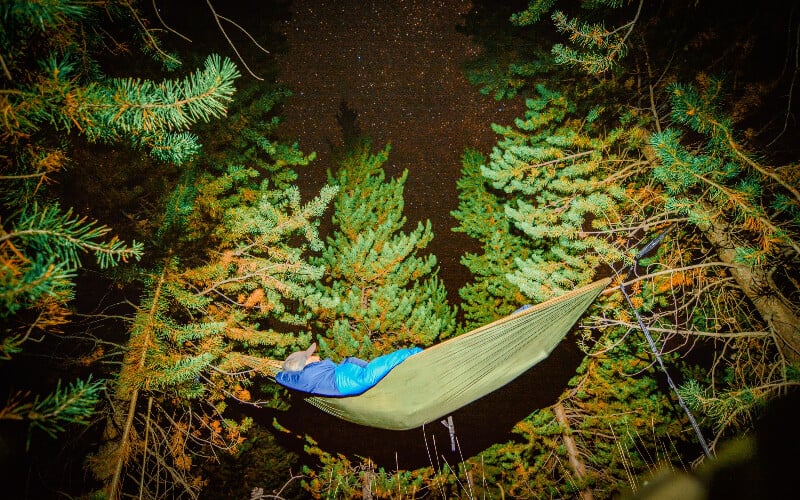
Just as with everything in life, there are pros and cons to camping in a hammock. If you’re thinking about becoming a hammock camper, keep the following in mind before you ditch the tent and dive in to working on your ideal hammock setup.
The Benefits of Camping in a Hammock
There are plenty of reasons people enjoy hammock camping. For starters, it’s an incredibly comfortable way to sleep off the ground and get a good night’s rest; some even claim that they feel more rested after sleeping in their hammocks vs sleeping on traditional camping mattresses or cots. There’s not a lot of studies on the health benefits of sleeping in a hammock, but there are plenty of anecdotal reports from campers who feel refreshed after a good night’s sleep.
Camping in a hammock also offers some advantages over traditional tent camping, as you don’t have to worry about the ground eating up your tent stakes or finding that perfect spot where the ground is firm enough for setting up camp. Another big bonus is the fact that you’re elevated above insects and critters that might roam through while you’re asleep.
Another perk is that if you’re into backpacking and hiking, you’ll be able to find a great backpacking hammock.
The Downsides of Hammock Camping
That said, there are some drawbacks-namely that it can be difficult and uncomfortable if you’re not prepared with the appropriate gear and accessories. Hammocks don’t offer as much shelter as tent, so you’re more exposed to wind, rain, and snow. However, if you plan ahead and bring the right gear (which we’ll discuss below), you can stay comfortable in almost any weather-though we don’t recommend sleeping in a hammock during a blizzard or in sub-freezing temperatures.
Another potential downside to hammock camping is you must find a spot with sturdy trees the proper distance apart in order to get set up. That’s not usually much of an issue when you’re in heavily wooded areas but can pose a bit of a problem if you’re camping in areas with little (or no) tree coverage. However, that issue can also be avoided with the right gear.
Choosing the Right Hammock
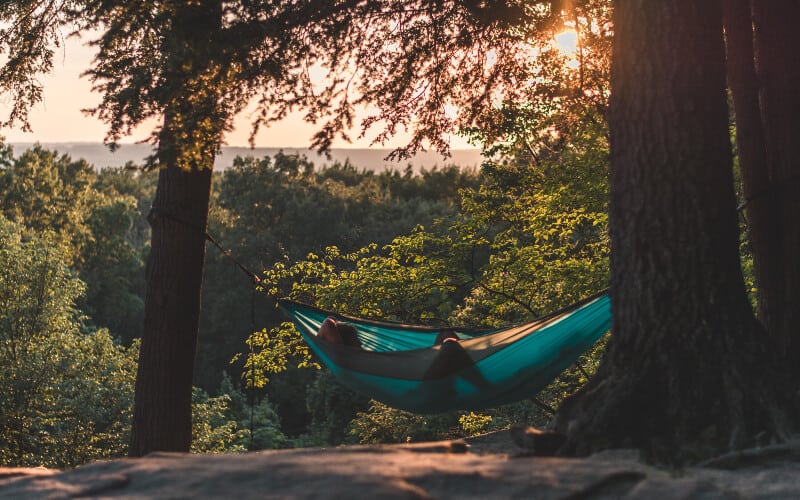
If you’ve decided that hammock camping is right for you, the next step before your outing is to find and purchase the perfect hammock and accessories for your trip. There are a wide variety of camping hammocks on the market, but the right one for you will depend on your preferences, needs, and budget.
For example, if you’re camping in a hot climate, look for options with mesh or mosquito netting to keep cool while you sleep. You’ll also likely need to bring along a rain fly or tarp to protect yourself from wind and rain. If you don’t plan on setting up camp near your vehicle or want to go hiking, it’s worth looking at an ultralight hammock that’s easy to pack and carry, while still being strong enough to hold your weight without tipping over from being overloaded.
Hammock Types
There are many great brands on the market, but before you worry about getting the latest ENO hammock (ENO SingleNest, anyone?), Hennessy Hammock, REI, etc., you should figure out what type of hammock you’re looking for. Only then should you commit to your specific hang hammock.
Single Hammocks
Commonly referred to as “day hammocks.” These are the common traditional gathered-end hammocks that are more prevalent than the other varieties, and they’re often a bit more narrow than the other types outlined below. For those who want to stay as mobile as possible, a single hammock may be your best bet. One of the main downsides is that since these hammocks are often smaller than others, they may not be as comfortable and spacious. These are often asymmetric hammocks, which allows for a person to sleep at a slight angle to help flatten the hammock.
Double Hammocks
Commonly referred to as “overnight hammocks.” These hammocks are wider than standard hammocks, making them more comfortable, and they can generally hold a lot more weight. While these hammocks can often hold multiple people (depending on weight limits), a double hammock is best used for one person to sleep in. A main downside of these hammocks is their bulkiness.
Bridge Hammocks
Also known as “lay-flat hammocks.” These hammocks have a spreader bar along the head and foot that help keep it flat. This can be immensely helpful, especially for people who have issues getting comfortable in more traditional hammocks (we discuss some tips for maximum comfort below), as it can take a little practice to figure out how to best lay in them. As with double hammocks, lay-flats tend to be bulky (especially with the added supports).
Tent Hammocks
The downside of most of the types above is that you’ll often need extra accessories to ensure a comfortable trip, but a tent hammock (sometimes referred to as a jungle hammock because the built-in bug net is almost essential in the depths of the jungle) is an all-in-one solution that comes with almost everything you need-including an insect/bug net, a rain fly, and a suspension system. These can be portable and light weight, though a downside is that they will likely cost significantly more than more traditional hammocks.
Hammock Materials
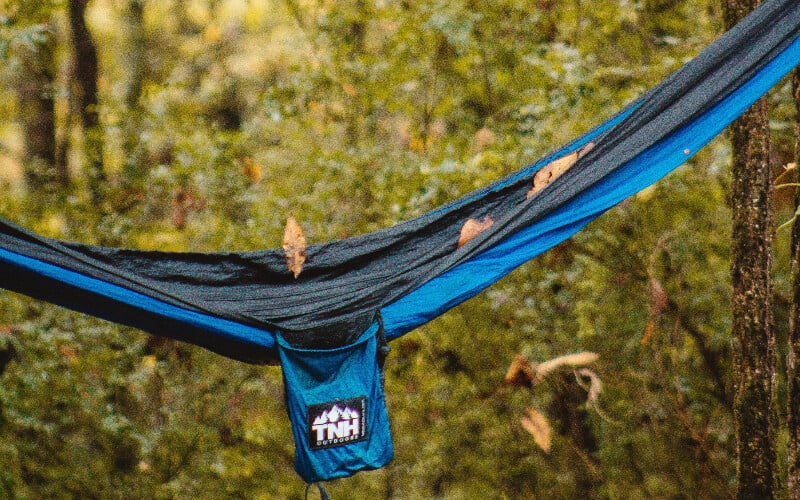
Hammock fabric is generally one of two materials (or a blend): cotton or nylon. Each material type has its own strengths and weaknesses, so it’s important to consider which material type will work better for your needs before you choose the perfect hammock.
Cotton Hammocks
Cotton hammocks are generally softer and tend to be more comfortable than nylon hammocks. They stretch and are gentler on your body. However, they aren’t as durable as nylon and require more care to maintain.
Nylon Hammocks
Nylon hammocks (sometimes referred to as a parachute hammock) are generally more durable and longer-lasting. The weight limit is often significantly higher for nylon hammocks, and they can usually stretch just enough hold up to two people without issue (though its recommended to sleep one person per hammock). They are also more durable for camping and hiking, though not quite as comfortable.
Hammock Accessories
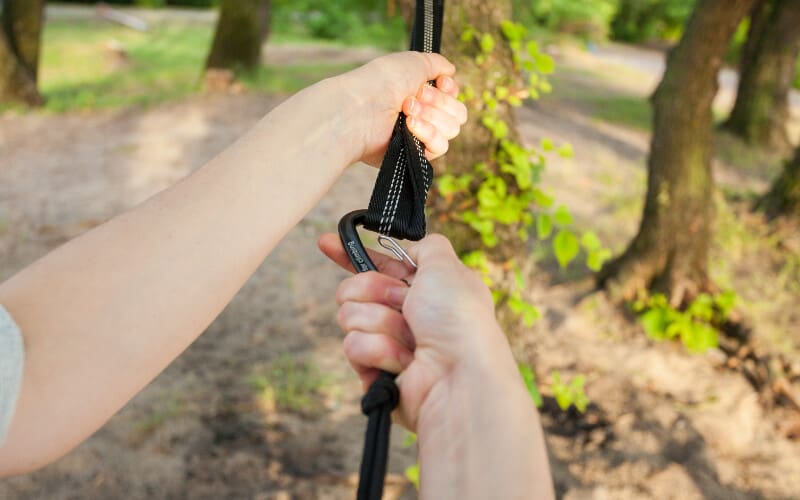
Whatever type you choose, you’ll want to make sure you bring the right hammock camping essentials on your trip. Even with a hammock tent, you’ll likely still be missing out on some important camping hammock accessories you want to consider packing.
Hammock Straps
While you can hang a hammock with any old thin straps or ropes, there’s a real chance you can damage the trees; the wrong straps can destroy or remove the trees’ bark, which leaves the trees open to damage from insects, animals, and the elements. Instead, it’s worth investing in a hammock suspension system that has tree-saving straps (aka webbing strap) that are designed to protect trees and leave no trace once your trip is over. Check out our tree strap reviews here.
Hammock Stand
If you’re staying in an area where trees are scarce, be sure to bring a suspension system with you so you can set up anywhere you can find firm, semi-level ground.
Hammock Ridgeline
A ridgeline is a simple cord that is used for gathered-in hammocks (i.e., most hammocks that aren’t bridge hammocks). You tie the ridgeline cord from the head to the foot of the hammock, and then adjust the tension to get the ideal sag.
Mosquito Net
A mosquito/bug net can help keep pesky bugs off you while you sleep. The last thing you want to do is wake up covered in mosquito, tick, or spider bites.
Rainfly
Unless you’re certain the weather is going to be ideal during your trip, packing a rainfly to protect you from the wind and rain is highly recommended. Even if the weather looks promising, a rainfly can add a layer of privacy that can be nice if you happen to be near other campers. Rainflies can be a bit expensive, so if you’re on a budget an old-fashioned rain tarp can work as a hammock tarp in a pinch. However, standard tarps aren’t as effective, and they are not nearly as portable (usually a tarp is bulkier, heavier, and takes up valuable space).
Sleeping Pad
Using a sleeping pad can really improve your overall experience. Not only can it add some stability while you’re lying down, but it adds an extra layer of cushion. The cushion adds more comfort and can help prevent heat from escaping through the bottom of your hammock. Even on moderate nights, sleeping suspended in the air can feel much cooler than sleeping on the ground, so unless it’s sweltering hot a sleeping pad is a handy accessory to have.
Hammock Underquilt
Underquilts are an alternative to sleeping pads, and they have a few pros and cons to consider before investing in one. While underquilts are generally more comfortable than sleeping pads, they’re often much more expensive. Additionally, they tend to be a bit bulkier, and can be a bit difficult to attach your hammock quilt properly.
Sleeping Bag
Even if you bring a sleeping pad or underquilt, it’s a good idea to bring a sleeping bag with you. Sleeping pads and underquilts go under you, but you’ll likely want to cover yourself while you’re laying down. If you don’t want to bring a full sleeping bag, a blanket is a good alternative choice-just be sure it will keep you warm enough in cooler weather.
Pillows
A pillow is another accessory that can really improve your hammock camping experience. Properly supporting your head and neck can mean the difference between waking up feeling refreshed or waking up with a sore back and stiff neck. Some sleeping bags have pillows built in, but if yours doesn’t be sure to bring one along with you.
Stuff Sack
Many hammocks come with a basic sack you can stuff it in when you’re packing up. If you want to organize your other hammock camping gear and keep everything together, there are more advanced options on the market that have multiple compartments designed to organize your gear (such as your tarp and insect net) in a convenient way.
Getting Your Hammock Set Up
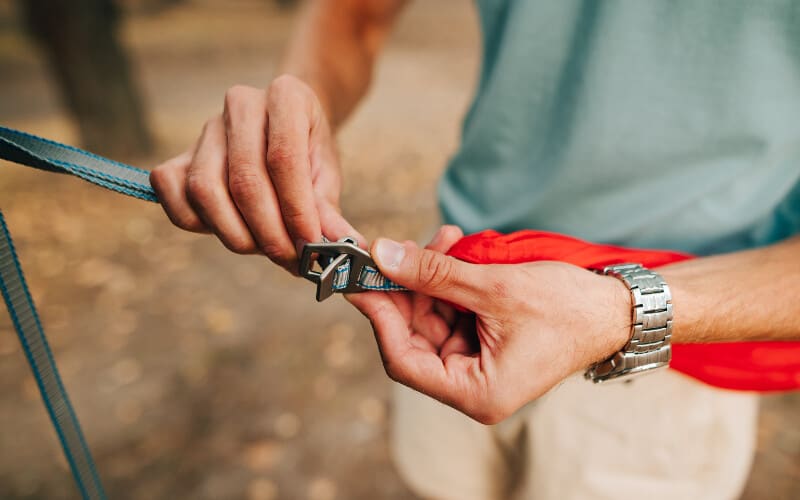
Now that you have your hammock and the right gear for your next outing, it’s time to get set up! No hammock camping guide is complete without some tips about how to make set up as easy as possible. Setting up for the first time can seem daunting, but with a little practice you’ll be able to do it in no time. Follow these tips to get make your set-up experience as smooth and painless as possible-and remember, the more you practice, the better you’ll get!
Arrive Early
If possible, try to plan your camping trip so that you arrive at your campsite with plenty of daylight left. Setting up can be tricky enough, but trying to get set up properly in the dark can make things way more difficult. In addition to setting up your hammock and the necessary accessories, such as your net and tarp, you’ll want to take some time to find the right spot and scouting around during the daylight will make the process much easier.
Find the Right Spot
Before worrying about the rest of the tips in this hammock camping guide, you’ll need to find the ideal spot to set up. Keep the following criteria in mind to help ensure you choose a great location before you start your hammock camping setup.
Stay Away from Water
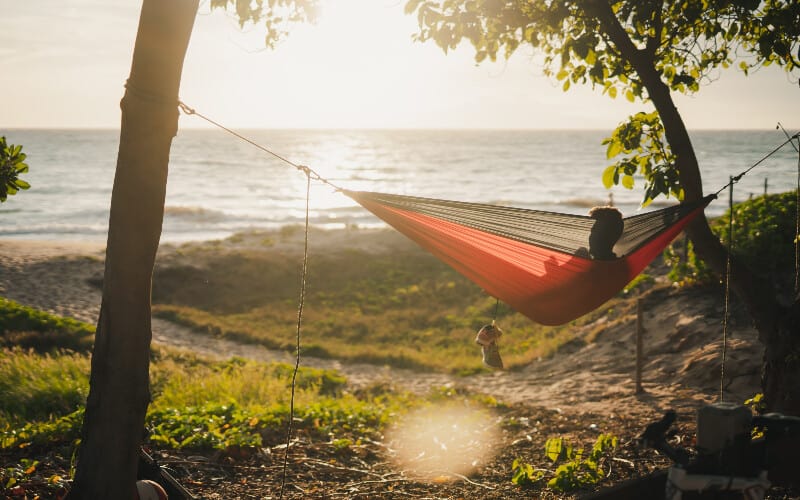
For starters, be sure you only consider spots that are far away from water. Marine life and the wildlife that live along shorelines and streams can be especially sensitive to humans, and it can be easy to unintentionally damage their habitats. Ideally, choose a spot at least 200 feet away from any water sources (if you aren’t sure if you’re far enough, it’s a good idea to err on the side of caution and push out a bit further).
Steer Clear of Trails
It may be obvious to avoid setting up over a hiking trail but be sure to look for signs of animal trails before you finalize your decision (look for wearing in the dirt and snapped twigs and branches). It’s important to strive to have as little impact on local wildlife as possible, and a human camping out in the middle of a frequented animal pathway can cause unnecessary distress.
Keep Away from Your Fire
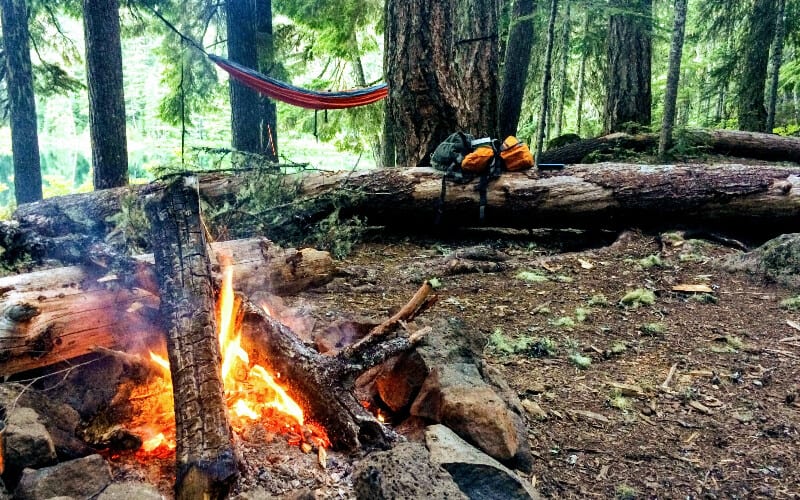
If you’re planning on building a campfire while you’re camping, be sure you plan where you’re going to build your fire before you commit to your hammock’s location. It may sound cozy to relax in your hammock close to your fire (especially when it’s cold), but you really don’t want to risk melting your hammock or accessories-or worse, risk catching your gear (and the surrounding plant life) on fire.
Choose the Right Trees
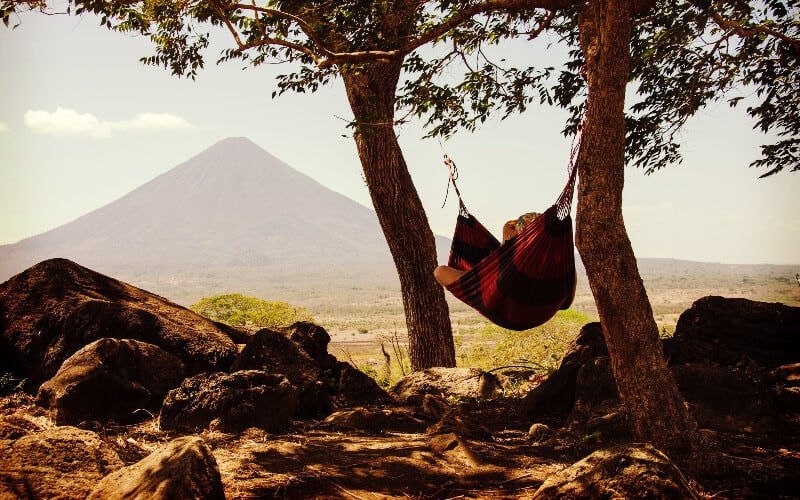
If you’re suspending your hammock between to trees, you’ll need to find the right two trees to suspend between (unless you’re planning on utilizing a stand-if so, disregard this section and jump to the next). First, find two trees that are sturdy and at least 11 feet apart. The average hammock is about 6.5 feet in length, so trees spread at least 10 feet apart give you a bit of space for your straps on both ends. Anything farther than 15 feet might stretch your hanging straps too far, so keep that in mind as well.
As you become more acquainted with your suspension system/hammock straps, you’ll get a better feel for the ideal tree distance (another reason to arrive at your campsite early!).
Avoid Less-Than-Ideal Ground
If you brought along a stand and plan on utilizing it, it’s extra important to ensure you pick ground that is suitable for the stand. Avoid marshy, moist, soft ground or you may find your stand sinking and becoming uneven as your evening progresses.
Additionally, avoid setting up above rocky terrain (or cacti, etc.) in case you accidentally fall out… the last thing you want is a nasty injury ruining your experience! This advice applies whether you’re suspending between trees or using a hammock stand.
Staying Safe & Comfortable

Once you’ve gotten fully set up, you can relax and enjoy the fruits of your labor. Keep these tips in mind to ensure you have a safe and enjoyable experience.
Keep Animals Away
When you’re out camping, you’re in the domain of the local wildlife that resides there-to them, you’re the interloper. With that said, most animals will steer well clear of your campsite while you’re there. However, some critters may be attracted to your food and be tempted to enter your camp to rummage around while you’re asleep. To prevent this, it’s important to keep food suspended high in the air or in animal/bear proof containers, which help prevent scents from seeping out.
Sleep Diagonally

For those who are new to all of this, it can seem a bit odd and uncomfortable. Fortunately, if you experiment a bit, you’ll be able to find the best sleeping position for restful, comfortable sleep. If you aren’t using a hammock that utilizes spreader bars, sleeping slightly diagonally will help keep you flatter-If you lay perfectly straight, you’ll sink down as the material folds around you, which may not be as comfortable for your back and neck.
Take Your Hammock Down When Not Around
If you’re planning on leaving your campsite unattended for a bit, it’s important to take your hammock down while you’re gone. While it may seem like a pain to take it down, it’s important to do so to help prevent accidentally trapping local wildlife if they get curious. Taking a minute to unclip your hammock from its straps can also save you a lot of money in damages if an animal decides to investigate, or if the wind kicks up and whips it around while you’re away.
Bring a Tent as a Backup

It may seem silly to bring a tent when you’re planning on spending your nights suspended in the air, but when you’re not used to this different way of sleeping it might be difficult to get a good night’s rest in on your first attempt. Bringing a backup tent on your first outing or two will help ensure you sleep well as you adjust. Plus, a tent can be beneficial for storing your gear and protecting it from the elements (this option offers a lot more protection than a tarp). However, if you’re backpacking, this may not be a feasible option.
Hammock Care & Maintenance
When you’re back from your trip, it’s important to spend a few minutes taking care of your hammock and accessories to help protect your investment and prolong the life of your gear for as long as possible.
First, consult your hammock’s user guide for any specific care tips. Generally, it’s a fairly simple process: just remove the metal clips (carabiners) and toss your hammock in the washer. Add mild detergent, set the water to cold, and run a gentle cycle to remove any dirt buildup. Once it’s cleaned, hang it up on a line to allow it to dry. Be sure to note any variants in the instructions we’ve outlined vs. the manual and follow its instructions instead.
Then, be sure you clean your accessories. If you used a rainfly or tarp, hose it down and gently brush any mud or dirt buildups off, then leave it out to dry. Wash your underquilt or sleeping pad according to its care instructions and allow to dry before storing.
Inspect your hammock straps to look for any dirt, and wash and dry them if needed. If you suspended your hammock between trees, keep a sharp eye out for tree sap. Sap can damage your straps and shorten their lifespan considerably, so it’s important to get rid of sap as soon as your trip is over. Fortunately, it’s a simple process: all you need to do is apply a generous amount of alcohol-based hand sanitizer to the sappy spots (be sure to test a small area of the strap first to ensure it doesn’t affect the color). As you work the sanitizer in, it will weaken and remove the sap.
Bonus Hammock Camping Tip: you can use this same technique to remove sap from your other camping gear, your clothes, and even shoes (again, be sure to spot-test in a small, inconspicuous spot on each item before committing to a full treatment).
Hammock Camping Guide Wrap-Up
If you put in a small amount of effort after each trip to take care of your gear, it will last you for years to come-it doesn’t take much effort and will save you a lot of money in the long run.
Now that you’ve read through this beginner’s guide to hammock camping, you should be more than prepared to get out there and explore nature knowing you’ll be a pro at setting up your hammock shelter in no time!

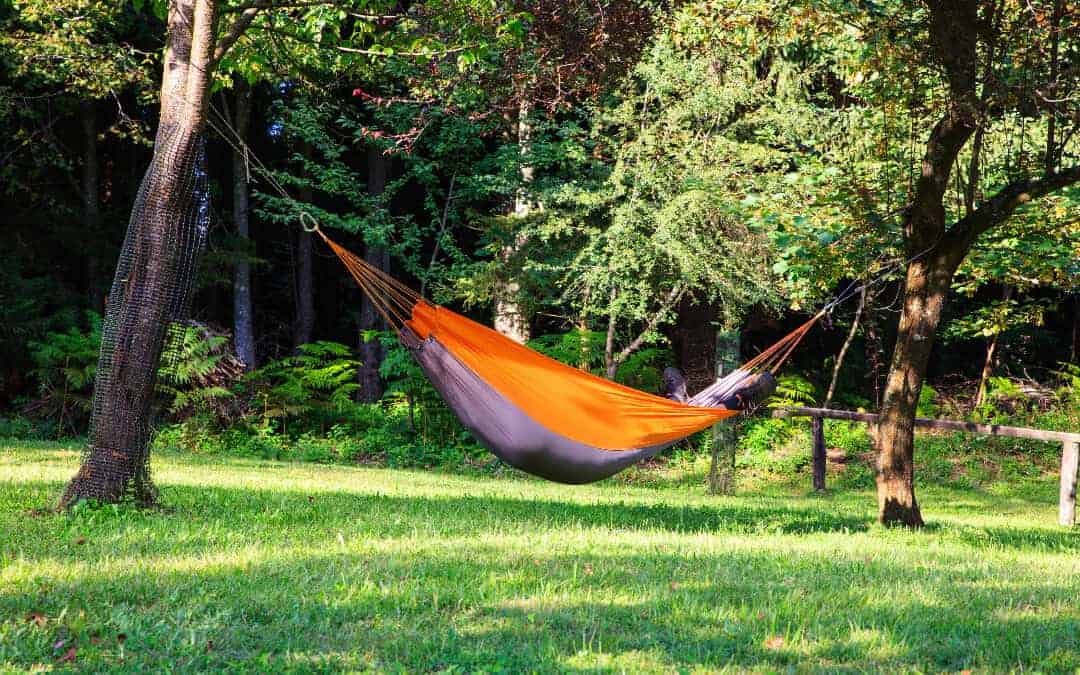
0 Comments